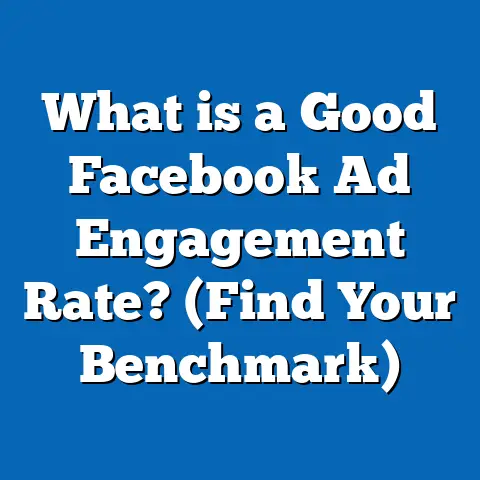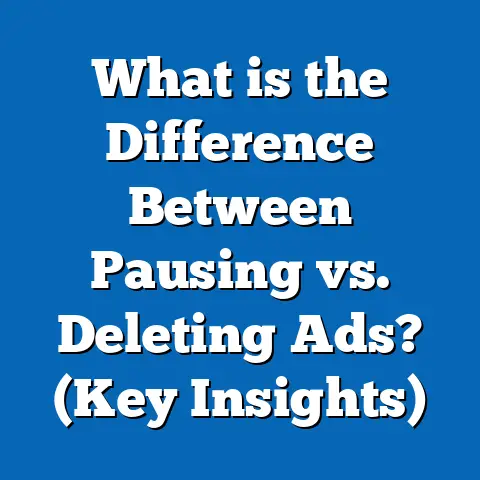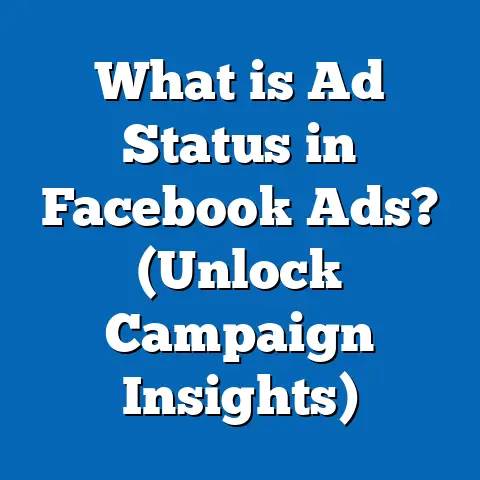What is UTM in Facebook Ads? (Unlock Tracking Success)
Introduction: The Power of Tech Innovations in Advertising Tracking
The world of marketing has been transformed by rapid technological innovations over the past decade. From automation to artificial intelligence, technology continues to disrupt and redefine how businesses reach their audiences. One of the most impactful advancements has been in digital advertising, especially platforms like Facebook Ads that allow businesses to target users with unprecedented precision.
However, with this complexity comes the challenge of measuring campaign effectiveness. Knowing how your ads perform and understanding where your traffic originates is critical for optimizing ad spend and maximizing ROI. Without accurate tracking, marketers are essentially flying blind.
Enter UTM parameters — a seemingly simple but incredibly powerful tool that has become fundamental to tracking success in digital advertising campaigns. These codes enable marketers to unlock detailed insights into campaign performance beyond what native Facebook reporting offers.
In this guide, you will learn everything about UTMs in the context of Facebook Ads. We’ll break down their purpose, explain how they work, share best practices, dive into advanced strategies, and explore real-world case studies. By the end, you will have the knowledge to implement a robust tracking framework that drives actionable insights and business growth.
What is UTM in Facebook Ads?
The Basics: What Are UTM Parameters?
UTM stands for Urchin Tracking Module. Originally developed by Urchin Software Corporation (later acquired by Google), UTM parameters are custom tags added to URLs to track the effectiveness of online marketing campaigns.
When someone clicks a URL containing UTM parameters, those tags send information about the traffic source back to your analytics tools. This helps marketers identify exactly where visitors come from and which campaigns or ads are driving traffic.
UTM parameters consist of five main components:
- utm_source — Identifies the origin of traffic (e.g., facebook, google, newsletter)
- utm_medium — Defines the marketing channel or medium (e.g., cpc, email, social)
- utm_campaign — Labels the specific campaign name or promotion
- utm_term — Tracks paid keywords or phrases (mainly for search ads)
- utm_content — Distinguishes different ads within the same campaign or A/B testing variables
For example, a URL with UTM parameters might look like this:
https://www.example.com/?utm_source=facebook&utm_medium=cpc&utm_campaign=spring_sale_2025&utm_content=ad1
This URL tells analytics software that the visitor clicked on a Facebook paid ad linked to the Spring Sale 2025 campaign and saw Ad 1 specifically.
Why UTMs Matter in Facebook Ads
Facebook Ads Manager provides detailed metrics like impressions, clicks, and conversions. However, it has limitations:
- It only shows data within Facebook’s ecosystem.
- It doesn’t track user activity once they leave Facebook.
- Attribution windows can be confusing or restrictive.
- Deep segmentation of traffic sources isn’t always available.
UTM parameters supplement Facebook’s data by feeding campaign details directly into external analytics platforms like Google Analytics. This allows marketers to:
- Track cross-channel performance in one place.
- Analyze user behavior on landing pages.
- Attribute conversions accurately.
- Understand which ad creative or targeting worked best.
HubSpot’s 2023 marketing report found that over 70% of marketers using UTM parameters reported improved tracking accuracy and better campaign insights compared to relying solely on platform-native reporting.
How UTM Tracking Works in Facebook Ads
Step-by-Step User Journey with UTM Codes
To understand UTM functionality, let’s follow a user’s interaction with a Facebook Ad that includes UTM parameters:
- Ad Display: The user scrolls through their Facebook feed and sees your ad.
- Click on Ad: They click the ad URL that contains UTM parameters.
- Landing Page Visit: The user arrives at your website with the complete URL including UTMs.
- Analytics Capture: Your analytics platform (usually Google Analytics) reads the UTMs and records traffic details such as source, medium, and campaign.
- Session Tracking: The analytics tool tracks the visitor’s behavior on your site—pages visited, time spent, conversions made.
- Report Generation: Data is compiled into reports showing which campaigns generated traffic and led to conversions.
- Optimization: Marketers use these insights to refine ads, targeting, and budgets.
Integration with Google Analytics
Google Analytics (GA) is the most common platform used alongside UTMs. When UTMs are correctly implemented:
- Traffic appears under Acquisition > Campaigns.
- You can filter by source/medium (e.g., facebook/cpc).
- Conversion goals set up in GA attribute sales or sign-ups to specific campaigns.
- Behavior flow reports show how visitors navigate after clicking an ad.
This integration provides a granular view that Facebook Ads Manager alone cannot deliver.
Detailed Breakdown of Each UTM Parameter
1. utm_source
This parameter identifies where your traffic originates.
Examples:
- newsletter
Best Practice: Always use consistent source names. For Facebook Ads, it’s typical to use “facebook” regardless of whether it’s feed ads or stories.
2. utm_medium
The medium describes the channel type.
Examples:
- cpc (cost per click)
- social
- banner
Best Practice: Use standard terms like ‘cpc’ for paid ads to maintain consistency across platforms.
3. utm_campaign
This parameter names your campaign to differentiate between promotions or product launches.
Examples:
- spring_sale_2025
- black_friday_promo
- brand_awareness_q2
Best Practice: Include dates or versions for easy segmentation over time.
4. utm_term
Mainly used for paid search ads to capture keywords but can be adapted for Facebook if needed.
Examples:
- running_shoes
- blue_widgets
5. utm_content
Used to distinguish between similar ads or creatives within the same campaign.
Examples:
- ad1_header_image
- video_ad_variant_a
Best Practice: Critical for A/B testing to know which ad version performed better.
Setting Up UTM Parameters for Facebook Ads: A Step-by-Step Guide
Step 1: Define Your Campaign Structure
Before tagging URLs, decide on a consistent naming convention for all parameters. This practice prevents data fragmentation.
Example format:
| Parameter | Format Example |
|---|---|
| utm_source | |
| utm_medium | cpc |
| utm_campaign | product_launch_june_2025 |
| utm_content | video_a |
Step 2: Create Tagged URLs Using URL Builders
Manually adding UTMs risks typos or inconsistent naming. Instead, use tools such as:
- Google Campaign URL Builder
- Third-party URL generators integrated into marketing stacks
Input your base URL and fill out each UTM parameter field, then generate the full tagged URL.
Step 3: Insert Tagged URLs into Facebook Ads Manager
When creating an ad:
- In the Destination URL field, paste the fully tagged URL.
- Alternatively, use Facebook’s dynamic URL parameters for scalable tagging (explained in advanced section).
Step 4: Test Your URLs
Before launching:
- Click each tagged URL yourself.
- Verify parameters appear in Google Analytics real-time reports.
- Check landing pages load correctly without errors.
Step 5: Launch Campaigns and Monitor Data
Once live:
- Monitor GA reports under Acquisition > Campaigns.
- Cross-reference with Facebook Ads Manager metrics.
- Use data to optimize bids, creatives, and targeting.
Case Study: How a Retail Brand Boosted ROI Using UTMs on Facebook Ads
Background
A mid-sized sportswear retailer struggled with accurately measuring which Facebook campaigns led to actual sales. Their Facebook Ads Manager data showed clicks but did not translate clearly into revenue figures on their backend systems.
Objective
Implement a tracking system using UTMs to attribute web traffic and conversions precisely from Facebook campaigns.
Strategy
They standardized UTM tagging with these settings:
| Parameter | Example Value |
|---|---|
| utm_source | |
| utm_medium | cpc |
| utm_campaign | summer_collection_2025 |
| utm_content | ad_banner_blue |
They also aligned Google Analytics goals with checkout completions.
Results After Three Months
| Metric | Before UTMs | After UTMs | % Change |
|---|---|---|---|
| Click-through Rate (CTR) | 2.1% | 2.4% | +14% |
| Conversion Rate | 1.8% | 2.2% | +22% |
| Return on Ad Spend (ROAS) | 3x | 3.6x | +20% |
| Customer Acquisition Cost | $45 | $37 | -18% |
With clearer attribution from UTMs, they identified which ads actually drove revenue and adjusted budgets accordingly, boosting overall efficiency.
Advanced UTM Strategies for Facebook Marketers
Dynamic UTM Parameters in Facebook Ads Manager
Manually tagging each ad URL becomes cumbersome at scale. Facebook Ads Manager supports dynamic parameters that automatically fill in values such as campaign name or ad set name when an ad is clicked.
Common dynamic parameters:
| Parameter | Example Usage | Output Example |
|---|---|---|
{{campaign.name}} | Campaign Name | summer_collection_2025 |
{{adset.name}} | Ad Set Name | women_18_24 |
{{ad.name}} | Ad Name | video_ad_blue_background |
You can build a dynamic URL template like:
https://www.example.com/?utm_source=facebook&utm_medium=cpc&utm_campaign={{campaign.name}}&utm_content={{ad.name}}
This automatically tags every click with accurate campaign details without manual input.
Combining UTMs with Facebook Pixel Data
Facebook Pixel tracks user actions on-site (page views, purchases) inside Facebook’s ecosystem but doesn’t provide source-level detail outside its platform.
Using both together allows:
- Cross-referencing Pixel conversion data with UTM-tagged traffic behavior in Google Analytics.
- Understanding multi-channel attribution better.
- Building highly granular retargeting audiences based on website behavior tied back to specific campaigns.
Multi-Touch Attribution Models Using UTM Data
Rather than last-click attribution, advanced marketers analyze multiple touchpoints throughout the customer journey using data from UTMs combined with CRM systems or marketing automation platforms.
This approach identifies all interactions—ads clicked multiple times across channels—helping optimize budget allocation more holistically.
Comparing UTM Tracking with Other Tracking Methods in Digital Advertising
| Feature | UTM Tracking | Facebook Native Tracking | Pixel Tracking |
|---|---|---|---|
| Data Granularity | High (source, medium, content) | Medium (campaign/ad level) | Event-level user actions |
| Cross-platform Tracking | Yes (Google Analytics etc.) | No | Limited outside Facebook |
| Attribution Models | Flexible (multi-touch etc.) | Limited | Focused on conversions |
| Setup Complexity | Manual tagging required | Built-in | Requires pixel installation |
| Data Ownership | Owned by advertiser | Controlled by Facebook | Shared between advertiser & FB |
UTM tracking provides essential cross-channel insights often missing from platform-only tools.
Common Mistakes Marketers Make With UTMs in Facebook Ads
1. Inconsistent Naming Conventions
Using variations like “Facebook,” “facebook,” or “fb” for utm_source fragments data and skews reports.
2. Forgetting to Tag All Links
Partial tagging creates incomplete data sets making analysis unreliable.
3. Ignoring URL Length Limits and Encoding Issues
Excessively long URLs can break links or cause errors. Always check proper URL encoding especially for special characters.
4. Overcomplicating Tags With Too Many Parameters
Excessive parameters confuse analysis without adding meaningful insight.
5. Not Testing URLs Before Launching Campaigns
Broken links or incorrect parameters mean lost tracking opportunities.
Emerging Trends in Advertising Tracking and Their Impact on UTMs
Privacy Regulations & Browser Changes Affecting Tracking Accuracy
Laws like GDPR (EU) and CCPA (California) restrict cookie tracking and personal data usage. Browsers like Safari and Firefox limit third-party cookies drastically through Intelligent Tracking Prevention (ITP).
UTM parameters track at the URL level and do not rely on cookies, so they remain a vital tracking method despite privacy changes.
Server-Side Tracking Gaining Popularity
More marketers are shifting from client-side (browser-based) tracking to server-side solutions that send event data directly from servers to analytics platforms for improved accuracy and data security.
UTMs still serve as key identifiers linking campaigns in this new infrastructure.
AI-Powered Attribution Tools Using UTM Data
Advanced marketing platforms now combine UTM data with AI-driven models analyzing multi-channel behaviors for more accurate attribution and predictive insights.
Practical Guide: Implementing UTM Tracking Successfully in Your Facebook Ads Today
Step 1: Plan Your Campaign Structure & Naming Conventions Carefully
Create a documented system everyone on your team follows strictly.
Step 2: Use Reliable Tools for Building URLs
Google Campaign URL Builder or automation tools ensure accuracy and save time.
Step 3: Incorporate Dynamic Parameters Where Possible
Use Facebook’s dynamic URL parameters for scalable tagging across large campaigns.
Step 4: Link Analytics Goals Clearly With Business KPIs
Set up Google Analytics goals reflecting sales, sign-ups, downloads relevant to your business objectives.
Step 5: Test Every Tagged Link Thoroughly Before Launching
Verify correct parameter passing and page load success for each ad link.
Step 6: Monitor Campaign Performance Regularly Using Both Facebook & GA Data
Compare data points for consistency and deeper insight into user behavior post-click.
Step 7: Adjust Budgets & Creative Based on Data Insights Continuously
Use data-driven decisions rather than guesswork to maximize ROI.
Frequently Asked Questions (FAQs)
Can I Use UTMs for Organic Facebook Posts?
Yes! Adding UTMs to organic post links helps track traffic from unpaid content separately from paid ads.
Do UTMs Affect My Ad Cost or Delivery?
No direct impact on cost or delivery; they only add tracking info to URLs without affecting ad mechanics.
Are UTMs Compatible With Other Social Platforms?
Absolutely! The same principles apply across Twitter, LinkedIn, Instagram, etc., enabling unified cross-channel measurement.
Summary & Clear Next Steps for Marketers and Business Owners
UTM parameters are indispensable tools for unlocking precise tracking success in Facebook Ads campaigns. They provide detailed insights beyond native reporting and integrate seamlessly with popular analytics platforms like Google Analytics.
By adopting consistent naming conventions, leveraging dynamic parameters, combining UTMs with Facebook Pixel data, and avoiding common pitfalls, marketers can:
- Attribute conversions accurately,
- Understand customer journeys,
- Optimize ad spend,
- Improve ROI significantly over time.
Start today by auditing your current campaigns for proper tagging or implementing UTMs in your next campaign launch. Regularly analyze data to refine marketing strategies based on real user behavior rather than assumptions.
Tracking success is no longer optional but essential in today’s competitive digital landscape — mastering UTMs gives you the clarity needed to win.






